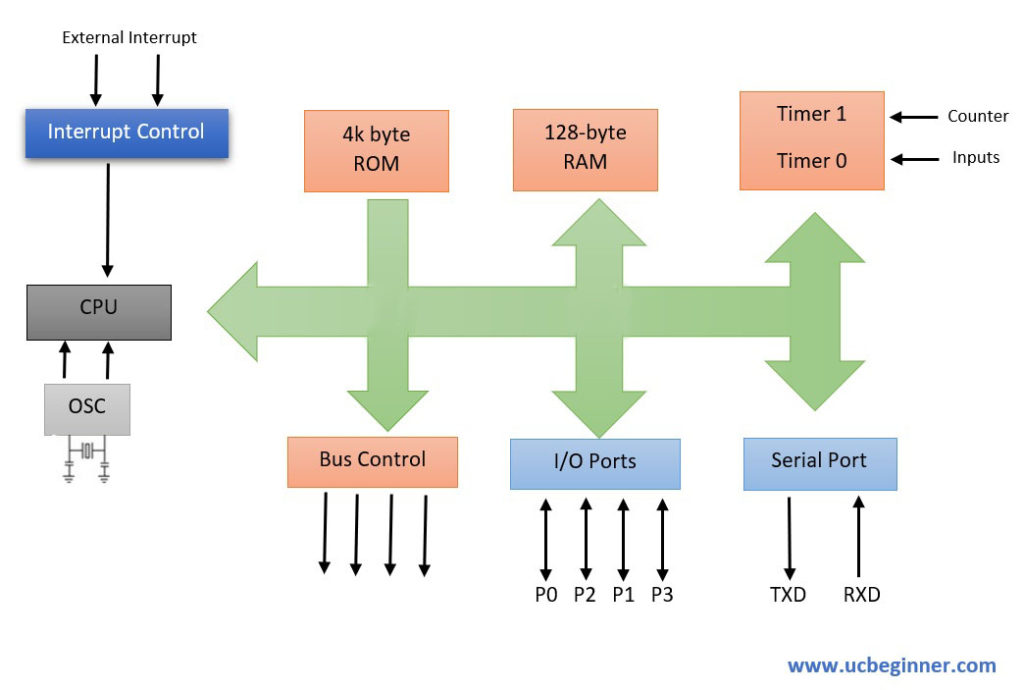What is a Microcontroller?
The latest microcontroller is 8 bit and has 128kb of RAM, 4kb of ROM, four ports, two timers, and one serial port integrated on signal chip. All functions execute on these chips by assembly language. In 1980 intel introduced the first microcontrollers 8051 and additional power by adding ADCs, Op AMPS, and other components. So the microcontroller 8051 (see Datasheet) consists of a 16-bit address bus for data transmission and an 8-bit data bus to transfer data for specific purposes.
Characteristics of Microcontroller 8051
- Bit microprocessor (see Microcontroller VS Microprocessor)
- Two times higher with 16-bit resolution
- 8-bit data bus
- 7-bit address bus
- Provides a bit addressable format
- Special function registers and a serial port
- 32 input/output
- 128-byte data memory and RAM
- 4 KB of program memory and ROM
The architecture of the Microcontroller 8051
In this blog, you learn about the internal architecture of microcontrollers 8051. Let’s have a look at the interior architecture of the microcontroller 8051 in the form of a block diagram, as seen below:

Basic components
1. CPU (Central Processing Unit)
The (CPU) works as the brain of any processing system. Its main aim is to control the different kinds of registers accessible in the microcontrollers 8051. CPU understands the software stored in ROM, executes it from storage, and performs its assigned task. It merges and controls all activities performed by the microcontroller. But the user does not influence how the CPU operates.
2. Interrupts
Interrupts give a mechanism to postpone and delay the present process. It also executes a subroutine task and then resumes the standard program when another program with a high priority requests the system when the currently running program interrupts occur.
3. Memory
The microcontrollers 8051 attach on-chip program memory (ROM) and on-chip data memory (RAM).
4. ROM
The microcontroller 8051 features a 4 KB ROM with addressable space ranging from 0000H to OFFFH. So at the time of construction, the operations by the device. But the microcontroller is stored in the ROM of the memory. So Code memory means that the programmer uses it to store programs executed by the microcontroller.
5. RAM
The 8051 has 128 bytes of RAM. It is also known as data memory since it briefly stores data. RAM is mainly used to store data or operands for a short period. The working registers take up the first 32 bytes of the 128-byte RAM. As with the 8051, the data and program memory, i.e., RAM and ROM, each have a specific memory area.
Essentially, they are four banks, each with eight registers. It changes at any moment to meet the user’s needs. These registries may be accessed using either their name or their address. So only one registered bank can use it at any moment. However, extra memory is required for specific applications to increase memory space; consequently, the 8051 microcontrollers need external RAM, ROM/EPROM.
6. Input/ Output port
The 8051 comprises four parallel 8-bit ports, resulting in 32 input-output pins. So, according to software control, all four ports operate bidirectionally, i.e., as either input or output.
7. Timer and Control Unit
Time slots generate a time lag between two occurrences. The microcontroller 8051 has two 16-bit timers that allow the system to create two delays simultaneously to create the proper delay.
Applications of Microcontrollers 8051
Microcontrollers in various applications use electronic devices such as keyboards and mice, autos, e-commerce, electronic home products such as ovens and washing machines. So that’s all for the fundamental architecture and properties of microcontrollers 8051.

No
I am Assembler Programmer of MCS-51.
thanks for your share
I am interested in learning the 8051 course
I will take course
Good morning,
I would like to learn more about family of microcontroller 8051, 87C51 etc.
Tank you.
Best regard